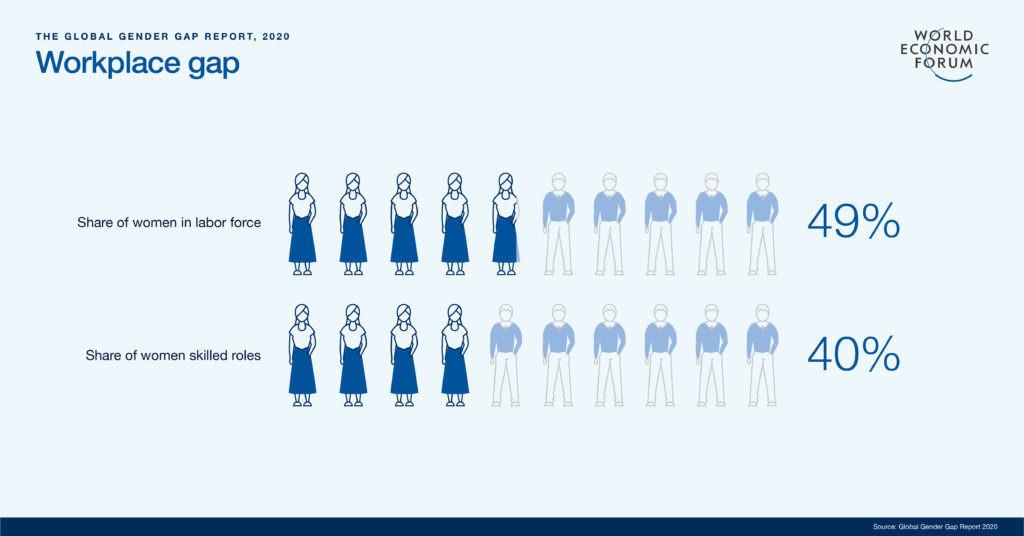by Geraldine Matchett, Carolyn Tastad and Martine Ferland*
• The case for gender equality has been made, but there is a lag to action.
• Companies are under-utilizing technology to achieve gender parity.
• Public policy could put in place the programmes that make the difference.
History is peppered with great female leaders. Just think of Boudicca or Christine Lagarde, Rosa Parks or Ruth Bader Ginsberg. Their legacies live in everything from monetary policy to civil rights. Yet, despite earning the majority of university degrees, women are still outnumbered in positions of power. We asked women at the top of their companies what they were doing to create a pipeline of strong female leaders. Here’s what they said:
According to Global Gender Gap Report 2020, only 36% of senior roles and 18.2% of top managers are women, and the World Economic Forum believes we should aim to achieve gender parity in leadership by 2030. What role do businesses play in achieving this goal?
Geraldine Matchett, co-CEO, Royal DSM: With women making up 50% of our company, we know it is unwise to forget half the population. Since leadership shapes how we operate and what we deliver, business can contribute to gender parity by hardwiring diversity into those value-adding roles that have the biggest potential impact on our outcomes, and on the customers and society, we serve. Ensuring diversity of mindset and approach is not only the right thing to do, but it also makes good business sense by bringing different perspectives to the table, and ultimately delivering solutions that better solve all of our customers’ problems.
Carolyn Tastad, Group President, North America, P&G: Most corporate leaders and decision-makers believe they are already addressing gender equality. But bias – both conscious and unconscious – gets in the way. And the result is a blind spot. As leaders and decision-makers, we only see part of the picture instead of the total landscape. This limits the way we act, react, believe and behave. It limits our effectiveness.
In the case of gender equality, we need to check our blind spots, so we can see the total picture. That’s the only way we’ll stop going backwards and start making forward progress. Let’s take workplace policies, as one example. Many companies have taken steps to improve maternity leave. And yet the workplace gender gap continues to grow. Why? Because maternity leave is a career inflection point that uniquely affects women.
What if workplaces developed policies and programmes that support women as mothers and men as fathers, with sufficient paid maternity and paternity leave? As more men experience the process of taking leave – securing manager approval, creating coverage plans, and navigating re-entry after several weeks away – company processes will improve for everyone, and more managers will be more empathetic to the needs of expectant parents.
Martine Ferland, President and CEO, Mercer: The business case for gender equality has already been made, and now we need to move to getting it done. We know that diverse teams bring value to organizations, and a substantial and growing body of research shows that companies with a more equal gender balance substantially outperform those without. But study after study shows that women, people of color, LGBTQ+ people and those with disabilities remain vastly under-represented in senior roles. Businesses can use data-driven insights to inform decisions and measure success, set clear and visible diversity and inclusion goals, and drive accountability and culture from leadership throughout the organization. It’s no longer just a focus for mature economies – it has evolved into an imperative for businesses around the world.
Within that framework, there are many areas for improvement on achieving gender parity. Mercer’s When Women Thrive 2020 global report – which surveys more than 1,150 companies in 54 countries and represents over 7 million employees worldwide – shows that a significant gap persists in data-driven and evidence-based decision-making. For example, 81% of organizations globally report that improving diversity and inclusion in high on their agenda, yet only 64% track gender representation. Even fewer track hires, promotions and exits by gender. And only 42% of organizations have a documented multi-year strategy, while just half set formal, quantitative D&I goals and targets. As businesses, if we want to get serious on accelerating the gender parity, we need to start taking actions rooted in data.

How will changes associated with the Fourth Industrial Revolution affect these strategies and need for inclusive business practices?
Geraldine Matchett, DSM: Digitalization offers many opportunities that can benefit and empower women, improve access to education and employment. However, history shows that women do not always benefit from this because of a lack of access to technology, skills gaps, and social or cultural barriers.
It doesn’t have to be this way; the future does not design itself. If transition in the Fourth Industrial Revolution is handled well, it could open the door to new and more highly rewarded roles for women. So this is a pivotal time for business to act consciously and make deliberate choices to ensure we are building inclusive organizations. We can start by reviewing the emerging roles that will be critical to our growth, and ensuring diversity in the pipelines that feed them. We can use the benefits of data available to review the impact of digital transformation on our workforce, ensuring that no group is adversely affected. Finally, we can create workplaces that enable digital upskilling, embed new ways of working, and build resilient and empowered employees.
Martine Ferland, Mercer: Just as organizations leverage technology to improve the efficiency and effectiveness of their business, the technology of the Fourth Industrial Revolution should be used to enhance diversity and inclusion (D&I) by delivering real-time data and insights, empowering leaders to make more informed people decisions.
In most aspects of D&I efforts – from data analysis, candidate-sourcing and selection, learning and development, talent management, employee communication, and health and well-being – correctly applied technology can enable consistent implementation of practices, processes and programs that support D&I. Yet our research shows only 30% of organizations are using technology to address such challenges.
It’s important for companies to ensure women are not at risk of falling even further behind in workforce participation, leadership roles and equal pay. The latest 2020 Global Gender Gap Report shows that women are more highly represented in roles hit hardest by automation. Generally, women tend to have shorter careers, are at lower wages, take more time off work to care for children or the elderly, and they live longer. It will be important for companies to review the changes that are needed in the workforce strategy with a gender lens to develop reskilling and transition plans accordingly.
How can businesses, governments and civil society collaborate to strengthen each other on the path to gender parity by 2030?
Geraldine Matchett, DSM: Business is not separate from society – we are part of it, and DSM makes this very clear in our purpose. Working in partnership with governments and civil society is core to how we deliver sustainable growth. We need to change the rules of the game together.
There are many ways to do this. Looking at the potential opportunities and risks for women in the future of work, we need to collaborate on education and skills programmes that enable access to high-value employment. DSM works hard to promote women in science and needs the support of policies and campaigns that encourage girls and young women into STEM education.
Transition or reskilling programmes, particularly for mid-career or women returning to the workforce, will ensure that women are not left behind. And we know that women’s access to education is often limited by caring responsibilities, so childcare subsidies for women (and men) in reskilling programmes would accelerate the transition.
Carolyn Tastad, P&G: Over the last few years, several big companies have been heralded for identifying and fixing pay gaps between women and men in the same roles. One could argue whether fixing a problem that shouldn’t have existed in the first place deserves celebration, but regardless, this is only the first step. What if – instead of being satisfied with fixing pay inequality – big business made fair pay the minimum standard, and income equality the new priority?
The Gender Gap Report describes the difference between the wage gap and income gap. The wage gap is the gap between how women and men are paid in similar positions. This is easy to spot and easy to fix in organizations committed to fair pay. The income gap is the difference in total wages earned by women vs. men. When more men than women hold more senior roles in an organization, there’s an income gap. The only way to address this is to achieve 50/50 representation at every level of the organization, including the C-suite.
Getting to 50/50 requires intentional, long-term talent planning at every level, including targets or quotas. But here, too, the typical approach of setting targets only for women is too narrow. We must tackle the numerator and the denominator by declaring hiring targets and representation quotas for women and for men. Our talent plans must encompass our total talent pool – not just a piece of it.
As world leaders internalize the stark realities in the Gender Gap Report, and as we look within our own organizations, we need every individual, every CEO and every leader to check their blind spots and embrace a broader set of steps required to close the gender gap.
Martine Ferland, Mercer: Collaboration among multiple stakeholders is key for improving gender equality. Mercer has partnered with the WEF on Closing the Gender Gap Accelerators to develop country-specific, data-driven approaches for enacting policies that will drive parity.
Over the past few years, pressure has grown for companies to report on the gender pay gap or comply with equal pay legislation that has begun around the globe. In the US, laws are being introduced at the city and state level, and at the national level in Europe and Australia.
But many countries still have policies that impede women’s economic participation. Civil societies, governments and businesses can work together through their advocacy efforts, by driving legislative reforms, and by implementing inclusive workplace policies and programmes to ensure there is a systemic approach to addressing gender inequality.
* Chief Financial Officer and co-CEO, Royal DSM NV and Group President, North America; Chief Sales Officer, Procter & Gamble and President and CEO, Mercer
**more on: www.weforum.org




 By: N. Peter Kramer
By: N. Peter Kramer
